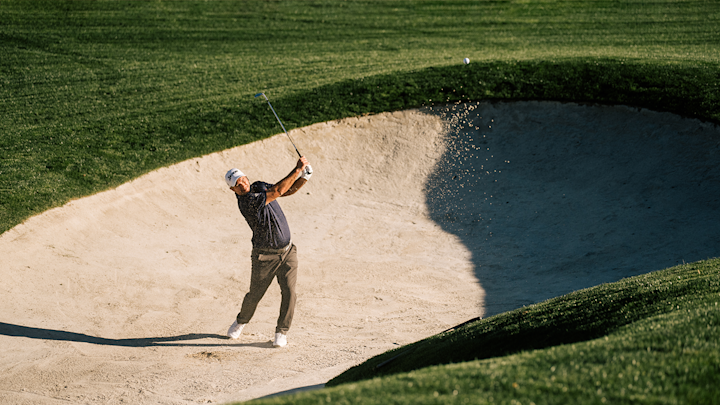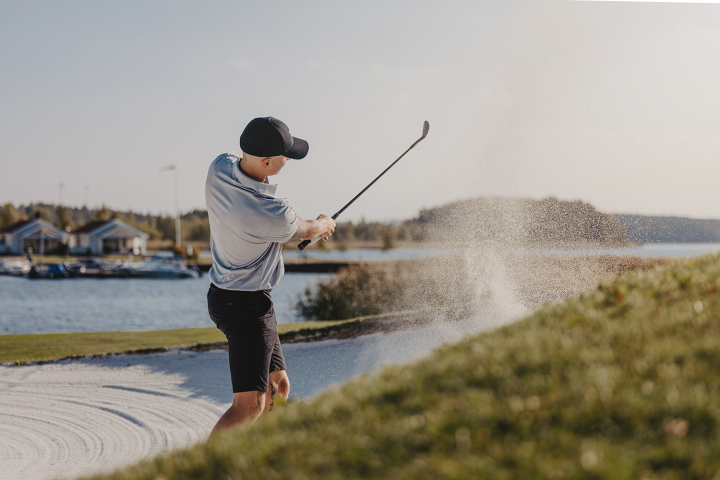Price guarantee - 14 days
Free returns
All prices are incl. VAT & Custom
Free shipping over £50

The Ultimate Wedge Guide
Loft. Bounce. Sole thickness. There's a lot to keep track of when choosing a wedge. Not quite sure where to start looking? The answer is here! Filip Karlsson at Dormy Örebro guides you through the most important steps on the path to a better purchase – and lower scores!
How to choose the right wedge - step by step
1. Which model do you want?
In the past, most wedges looked quite similar, but development has moved forward. Just like with regular irons, there are now wedges that are more or less forgiving to play with. However, due to the shorter shafts, high loft, and the fact that you rarely take full wedge shots, most players don't need as much help as with other clubs. For delicate shots around the greens, many players prefer the more classic models that are designed to let you work the ball. But if you feel uncertain, you should definitely look at the more forgiving options.
2. Decide on the number of wedges
In recent years, the lofts in standard sets have become stronger (i.e., lower). There are now sets being sold with pitching wedges at 41 degrees loft, when they were previously much higher. This creates larger loft gaps and a need for more wedges. A wedge between your pitch and your first "short game wedge", a gap or approach wedge, is now often a relevant choice for many. But it's the loft of your pitching wedge that determines this, and if you don't know how many degrees it has, we'll help you find out. Beyond a pitching wedge, most people usually choose two or three additional wedges. What suits you best depends on the types of shots you want to hit and what strengths and weaknesses you feel you have. The trend among tour players is that more and more are going down to only two wedges in addition to their pitching wedge, to make room for more clubs in the bag for slightly longer shots. It can be good to check the character of your home course to determine how many and which wedges you need in your bag, and we're happy to help figure out what suits you best.
3. Find your lofts
We usually recommend between 4-6 degrees loft difference between the clubs in the bag. If you start from your pitching wedge, which normally has a loft around 43-46 degrees, the next wedge should be around 48-50 degrees. Once the first wedge's loft is established, you can continue to maintain that loft gap or create an interval you're comfortable with playing-wise if you only choose two wedges. Do you need a lob wedge at 58-60 degrees? It's a very useful club for different types of finesse shots around the greens, but it does require quite a bit from the player.

FILIP KARLSSON
Dormy Örebro
4. Choose sole and grind
Today, there is a wide selection of different types of soles and grinds available on many of the most prominent models. This is excellent since we all have different uses for our wedges. A wide sole makes the club more forgiving and reduces the risk of digging into the ground on a duff shot. A wide sole is also preferable on your sand wedge, as it helps with bunker shots. A slightly narrower sole becomes somewhat more challenging for most players, which is generally recommended for skilled golfers who prefer the ability to manipulate ball flight rather than having forgiving characteristics. Regarding grinds, it's more difficult to speak in general terms, as it depends more on how you play your golf. Therefore, we suggest getting help from our store staff or Dormy Customer Service when making these choices if you don't feel completely confident choosing on your own.
5. Which bounce for which wedge?
Simply put, bounce is the club's tendency to bounce off the surface we're hitting from. Whether a club has more or less bounce is determined by how the clubhead is designed. The technical aspect of what creates more or less bounce in the clubhead design is determined by the angle from the leading edge of the clubhead's sole to the back edge of the clubhead, in relation to the ground when we address the ball. The larger this bounce angle, the higher the bounce of the club. If the bounce is high, it becomes difficult to get under the ball on hard surfaces, while a lower bounce makes this easier. On soft ground, a wedge with too little bounce can dig in, making higher bounce preferable.
A good first step is to consider the characteristics and ground conditions of your home course.
Then, the loft of the wedge in question also determines which bounce you should have – you rarely have the same bounce on your 48-degree and 60-degree wedges.
A low bounce (4-7 degrees) suits:
→ If you have a sweeping swing and take little turf.
→ If your course has hard ground conditions.
→ If there's little or compacted sand in the bunkers.
A medium bounce (8-11 degrees) suits:
→ If you take normal-sized divots.
→ If you use the wedge for different types of shots.
→ If there's a normal amount of sand in the bunkers.
A high bounce (12-16 degrees) suits:
→ If you hit down steeply on the ball and take large divots.
→ If you often play on soft courses.
→ If there's a lot of sand in the bunkers where you play.
Alternative wedge setups:
Example 1.
If you want to add two wedges (in addition to PW), it's important that the wedge with the highest loft functions as an all-round club. Since you'll only have one wedge with high loft, it needs to be versatile for bunker shots, lob shots, fairway and rough. In this case, a mid-bounce is preferable.
50 degrees with 7-10 bounce
56 degrees with 9-12 bounce
Example 2.
If you want to carry three wedges, it's important to know how you plan to use the 54-56 and 58-60 degree wedges. If both need to work for bunker shots and around the green, a mid-bounce is a good choice.
50 degrees with 7-10 bounce
54-56 degrees with 9-12 bounce
58-60 degrees with 7-10 bounce
Example 3.
Is your plan to use the 54-56 degree as your bunker club and the 58-60 for lob shots, without using it in bunkers?
50 degrees with 7-10 bounce
54-56 degrees with 12-14 bounce
58-60 degrees with 4-7 bounce
Which bounce is right for you?

Questions and answers about wedges
There are many questions to ask before purchasing new wedges. Here are the answers to some of the most important ones.
Which shaft should I choose?
The majority of wedges you see in shops are sold with a relatively heavy steel shaft, which naturally doesn't suit all golfers. Recently, more manufacturers have expanded their standard range and now offer certain wedges with graphite shafts. We typically recommend matching the shaft in your wedges with the shaft in your irons to maintain the same feel regardless of which club you're using. All wedges in our standard range can be ordered with various shaft options, and our experts in our stores are happy to help you choose the right one.
Is it true that a wedge is worn out after 75 rounds?
When it comes to wedges, we often talk about "bite". How sharp, deep, and numerous the grooves on the face are affects the friction between the clubface and the ball at impact. The sharper the grooves, the better the bite. This is what you want when trying to stop the ball on the green or create backspin.
It's true that when a wedge approaches 75 rounds (or alternatively 50 rounds plus countless hours in the practice area), the grooves start to wear down and lose their grip. You always get better control and spin with new wedges with fresh grooves, and tour players change their wedges about three times per season. However, the average golfer won't notice as significant a difference as the world elite, so their wedges tend to last a bit longer. But it's worth keeping in mind if you're trying to generate spin with a well-used wedge from 2003.
Can you refresh the grooves yourself?
When wedges start to get tired, many might be tempted to dig out a small screwdriver from their toolbox and sharpen the grooves themselves. However, this is actually forbidden. Just as there are limitations on how much the face of your driver can flex, there are rules regarding the depth and width of the grooves on your wedges.
Manufacturers naturally maximise these specifications from the start, which means that as soon as they're modified even slightly with a screwdriver in an unsteady hand, they become non-conforming. If you feel your wedges are getting dull, it's simply time to acquire new ones.
Which club should I choose for lob shots?
For lob shots, you need a club with high loft so you can open the clubface properly. There are also wedges specifically designed for this – with a higher toe profile and grooves across the entire face, such as the Callaway Full Toe or Cleveland Full Face. This makes the wedge perfect for lob shots. It's also incredibly versatile as it's designed to generate spin in all situations – whether you're hitting from a bunker, fairway, or rough.
Are there wedges for children and juniors?
A smooth transition from junior sets is to move to ladies' clubs – the same applies to wedges. With all the adjustable details in today's golf clubs, it's no problem for our workshop to cut down a shaft, change the lie angle, or adjust the loft. A shortened ladies' shaft makes the wedge lighter and easier to swing. In most cases, it's also easier to hit with a wedge that has a slightly wider sole.
How important is it to have the correct lie angle?
The lie angle is the angle between the shaft and the club head's sole. When you set up to hit and address the club head, the centre of the sole should rest against the ground.
While you can't blame everything on your clubs, a persistent right or left miss could actually be due to an incorrect lie angle.
Important, in other words. Considering that the constant left miss on your approach shots likely often ends up in a greenside bunker. And a consistent right miss likewise. We can help you look at this in our stores.
